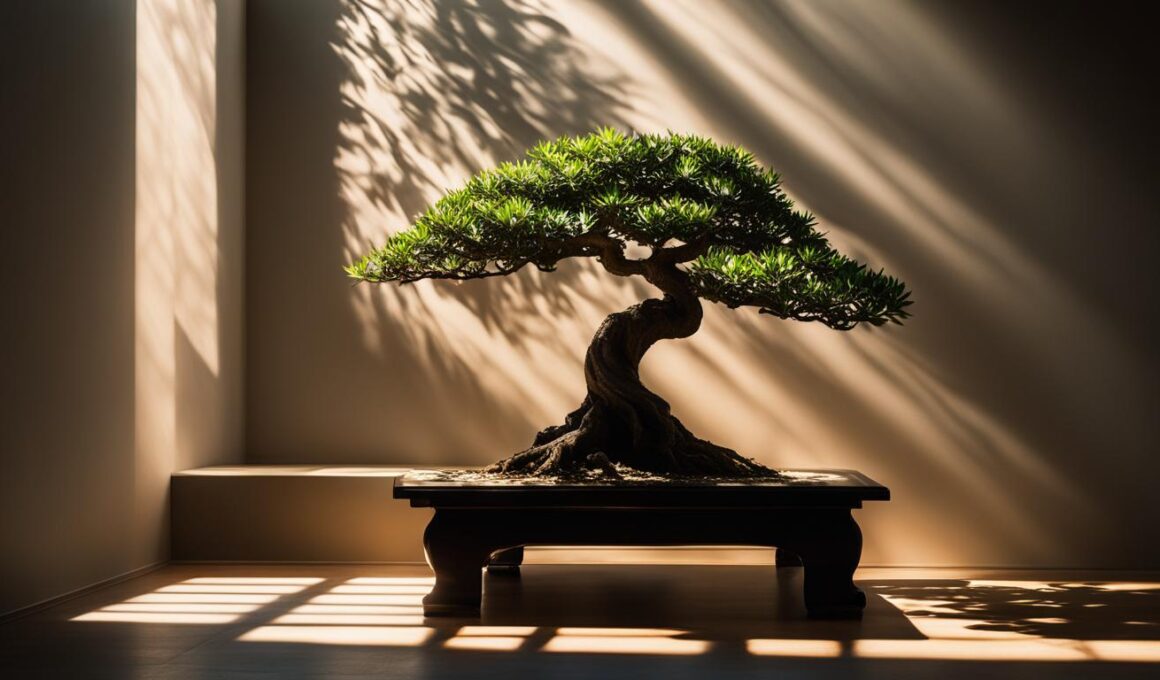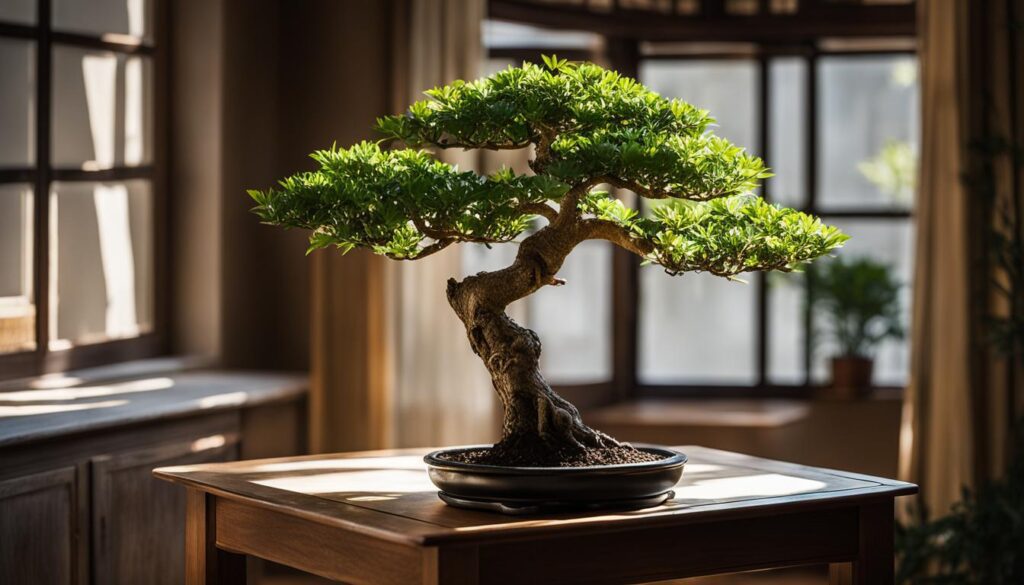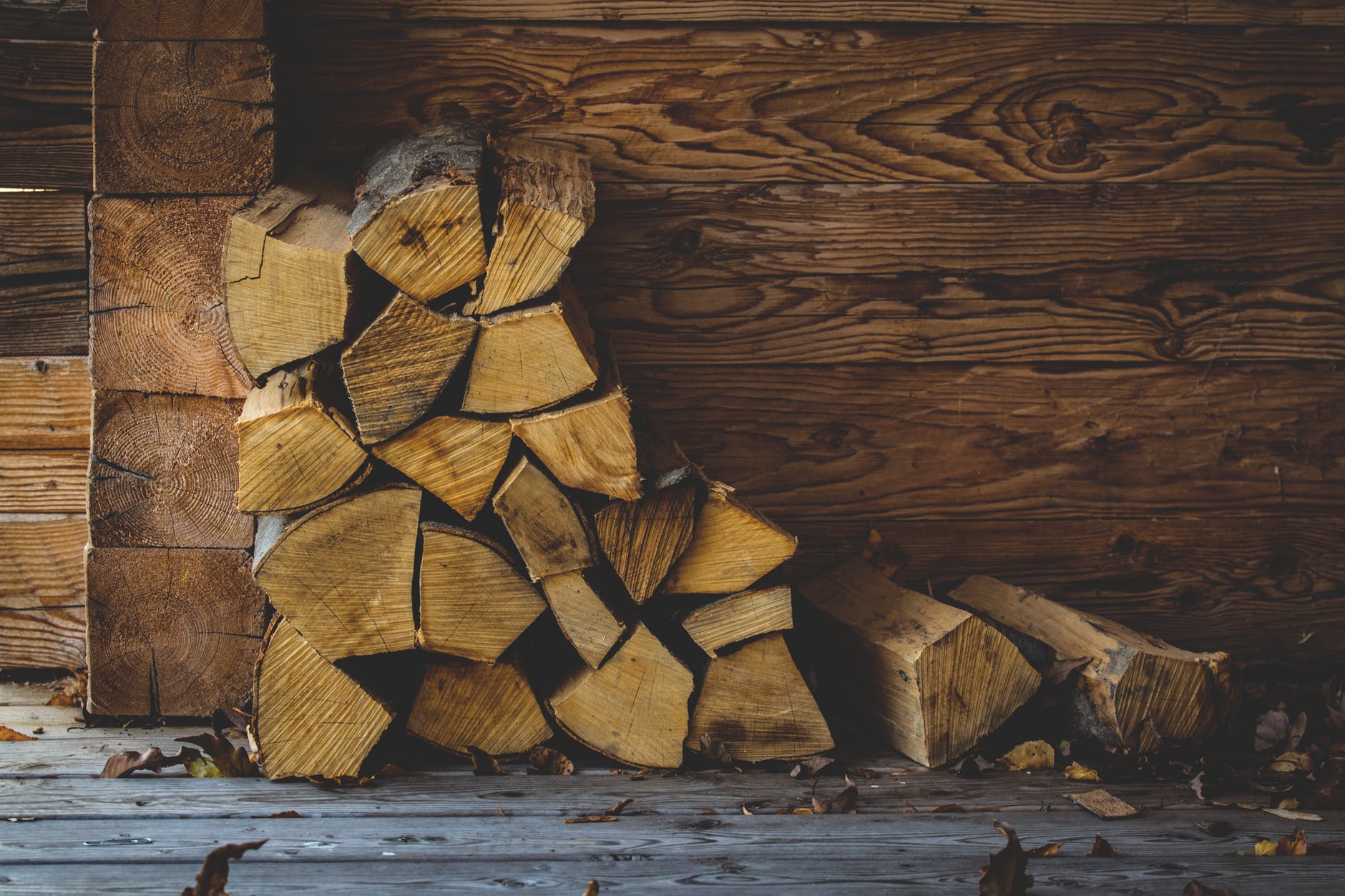Like their full-sized counterparts, Bonsai trees rely on sunlight for various aspects of growth and maintenance. The sun plays a vital role in Bonsai care, significantly influencing the health and development of these miniature trees. To achieve optimal growth, both indoor and outdoor Bonsai should receive direct sunlight for 5-6 hours daily. Without adequate sun exposure, Bonsai may exhibit weak growth and face various health issues. Whether small or large, Bonsai trees count on sunlight to be their primary source of sustenance, and meeting these light needs is crucial regardless of where they are placed.
Key Takeaways
- Direct sunlight is crucial for optimal Bonsai growth and health
- Both indoor and outdoor Bonsai require 5-6 hours of sunlight daily
- Insufficient sun exposure may result in weak growth and health problems
- Different Bonsai species and environments may require tailored sunlight approaches
- Maintaining proper sun exposure promotes better resistance to pests, diseases, and unfavorable conditions
The Essentials of Bonsai Sunlight Requirements
Light is crucial for the photosynthesis process in Bonsai, impacting their ability to thrive. Sunlight requirements may vary depending on the specific Bonsai species, but generally, 5-6 hours of sun exposure is recommended. Both indoor and outdoor Bonsai trees have a preference for direct sunlight, which greatly influences their health and growth. Ensuring that Bonsai receives adequate sunlight plays a fundamental role in their general Bonsai tree care, with various strategies available for those kept indoors where natural light may be insufficient.
In order to provide optimal sunlight for Bonsai, it’s essential to recognize the light requirements of different species. Common Bonsai species and their light preferences are summarized in the table below:
| Bonsai Species | Preferred Sunlight |
|---|---|
| Ficus | 5-6 hours of direct sunlight |
| Juniper | 6+ hours of direct sunlight |
| Chinese Elm | 4-6 hours of direct sunlight |
| Maple | Partial sun, ideally morning and late afternoon light |
| Boxwood | 4-6 hours of direct sunlight |
When tending to indoor Bonsai, it’s essential to find creative ways to ensure the tree gets enough sunlight as this may require repositioning or relying on artificial light sources. Some strategies to address the essential Bonsai light requirements include:
- Placing the Bonsai near a south- or west-facing window for maximum sunlight exposure.
- Rotating the tree periodically to ensure all sides receive equal light.
- Using a grow light to supplement sunlight during periods of low light or when adequate natural light is not available.
Outdoor Bonsai trees also need specific attention when it comes to light placement. It’s essential to monitor temperature fluctuations in sunny areas and adjust Bonsai placement accordingly, ensuring the tree is not adversely affected by the varying light conditions throughout the day. In general, positioning your Bonsai in an area that provides balanced sunlight will greatly contribute to its overall health and growth.
Indoor vs. Outdoor Bonsai: Sunlight Considerations
When it comes to Bonsai care, one of the most critical aspects to consider is sunlight exposure. Both indoor and outdoor Bonsai trees require different approaches to ensure they receive the optimal amount of sunlight necessary for healthy growth and development. In this section, we will explore the importance of location for indoor Bonsai, as well as how to maximize sun exposure for outdoor Bonsai trees.
The Importance of Location for Indoor Bonsai
Indoor Bonsai trees require careful consideration regarding their placement to ensure sufficient sun exposure. A sunny windowsill is often an ideal location for tropical species, which thrive indoors year-round. However, these indoor Bonsai trees also benefit from outdoor sun during warmer months, providing an extra boost to their overall well-being. To address the lack of humidity indoors, techniques such as the use of pebble trays or frequent misting may be necessary.
Even though some Bonsai species can adapt to low-light conditions or survive with artificial lighting, positioning Bonsai near natural light sources remains crucial for their health. The following table showcases different indoor Bonsai species and their optimal lighting conditions:
| Bonsai Species | Ideal Location | Preferred Sun Exposure |
|---|---|---|
| Ficus | Sunny windowsill | Partial to full sun |
| Jade | South or west-facing window | Direct sunlight |
| Chinese Elm | Bright and airy room with indirect sunlight | Partial shade |
Maximizing Sun Exposure for Outdoor Bonsai
Outdoor Bonsai trees should receive ample sunlight according to their natural habitat requirements, with a preference for direct sun exposure. Cold hardy Bonsai varieties, which cannot be kept indoors due to their need for dormancy periods, should be maintained outside in sunny locations until winter protections are necessary. Appropriate sun exposure, along with measures to prevent or mitigate freezing temperatures, supports the tree’s dormancy cycle and overall vitality.
One practical method for ensuring that outdoor Bonsai receive adequate light is to rotate their position periodically. This allows every part of the Bonsai to enjoy direct sunlight, promoting even growth and development. The following list outlines some general guidelines for maximizing sun exposure in outdoor Bonsai varieties:
- Position the tree in a location that receives direct sunlight for at least 5-6 hours per day.
- Rotate the tree every few days to ensure all sides receive equal sun exposure.
- Adjust the tree’s location and orientation seasonally to account for changes in sun exposure and temperature.
In conclusion, understanding the sunlight requirements of both indoor and outdoor Bonsai trees is essential for maintaining their health and ensuring their successful growth and development. By paying close attention to factors such as optimal location, sun exposure, and temperature, you can create the ideal environment for your Bonsai tree to thrive.
The Impact of Sunlight on Bonsai Health and Growth
Proper sunlight plays a critical role in determining the Bonsai health and plant growth of Bonsai trees. Insufficient light can cause a range of issues, such as leggy branches, larger than normal leaves, and reduced vigor, as the Bonsai attempts to compensate by reaching towards light sources. On the other hand, optimal sunlight exposure can enhance the tree’s resistance to pests and disease, encourage healthy metabolic functions, and avert issues related to overwatering and mold development by promoting quicker evaporation and better soil conditions.
Here are some specific ways sunlight impact on Bonsai health and growth:
- Foliage development: Adequate sunlight exposure makes for vibrant, dense foliage, while insufficient light can result in sparse, weak leaves.
- Photosynthesis: Sunlight is essential for Bonsai trees to conduct photosynthesis, the process that allows them to produce energy for growth and cellular functions.
- Resistance to pests and diseases: Healthy trees are more resilient to various pests and diseases, making proper sunlight exposure essential for Bonsai survival.
It is essential to understand the specific sunlight needs of your Bonsai species in order to provide the right amount of light and ensure their overall health. The table below outlines some general guidelines for sunlight requirements based on Bonsai species:
| Bonsai Species | Sunlight Requirements |
|---|---|
| Ficus | Direct sunlight for at least 6 hours a day |
| Juniper | Direct sunlight for at least 6 hours a day |
| Maple | Partial shade, with direct sunlight in the morning and late afternoon |
| Pine | Direct sunlight for at least 6 hours a day |
| Azalea | Direct sunlight in the morning and partial shade in the afternoon |
To ensure that your Bonsai trees receive adequate sunlight, make sure to keep an eye on the tree’s growth and overall health. Look for signs of light deprivation, such as elongated branches, large leaves, or moldy soil, and adjust the tree’s positioning accordingly. By providing the appropriate amounts of sunlight tailored to the specific needs of your Bonsai tree, you can foster optimal growth and maintain a healthy, thriving tree.
Understanding the Sunlight Needs of Different Bonsai Species
Each Bonsai species has its unique sunlight and temperature requirements, making it essential for enthusiasts to learn and adapt their care practices accordingly. The two primary categories include tropical Bonsai trees, native to warm and humid environments, and cold hardy Bonsai trees, which undergo seasonal changes and require outdoor exposure.
Tropical Bonsai Trees and Sunlight
Tropical Bonsai species have high sunlight requirements and thrive when positioned near natural light sources. Ideal for indoor cultivation, tropical Bonsai trees should be maintained at temperatures above 45 degrees F to prevent damage from cold conditions. One popular method of providing sunlight for indoor tropical Bonsai involves situating them on a sun-bathed windowsill year-round.
- Ficus
- Jade Plant
- Bougainvillea
- Schefflera
Considering their origins in humid environments, tropical Bonsai trees may struggle with dry indoor air. To combat this, enthusiasts can take several measures to increase humidity. These strategies include using pebble trays beneath the tree’s pot and misting the foliage regularly.
Cold Hardy Bonsai Trees and Sunlight
In contrast to tropical species, cold hardy Bonsai trees experience distinct seasons and require outdoor sun exposure from spring until autumn. As temperatures decrease, these trees enter a dormancy phase. During this period, they must be relocated to a frost-free but unheated area, where they won’t need sunlight until they reawaken in spring. Providing appropriate light exposure and temperature conditions aligns with the intrinsic growth cycles of cold hardy Bonsai, ensuring their survival through seasonal shifts.
- Japanese Maple
- Juniper
- Elm
- Pine
Ultimately, understanding the specific sunlight and temperature needs of each Bonsai species is integral to their successful cultivation and long-term health. By learning about the natural habitats of tropical and cold hardy Bonsai trees and replicating these conditions as closely as possible, enthusiasts can optimize growth and enjoy the rewarding process of caring for these beautiful miniature trees.
Artificial Lighting: Supplementing Sunlight for Bonsai Trees
In situations where natural sunlight is inadequate, artificial lighting offers a viable alternative for Bonsai care. Artificial grow lights for Bonsai can replicate the beneficial aspects of UV light from the sun, supporting the Bonsai’s growth and well-being.
These artificial sources are particularly advantageous in low-light environments or during seasons when daylight hours are limited. They allow for continued care and maintenance of Bonsai irrespective of natural light availability, ensuring that trees lacking sunlight do not succumb to the negative effects of light deprivation.
Types of Artificial Grow Lights for Bonsai
There are several types of artificial grow lights suitable for supplementing natural light in indoor Bonsai care. These include:
- Fluorescent lights
- High-Intensity Discharge (HID) lights
- Light Emitting Diode (LED) lights
- Compact Fluorescent Lights (CFLs)
Each type of grow light has its advantages and drawbacks, making it crucial to understand their individual features when selecting the best option for your Bonsai tree.
Choosing the Right Artificial Light for Your Bonsai
When choosing the appropriate grow light for your Bonsai, take into consideration the following:
- Bonsai species and their specific light requirements
- Available space for setting up the lighting system
- Budget and energy efficiency
- Desired intensity and spectrum of light
| Grow Light Type | Advantages | Disadvantages |
|---|---|---|
| Fluorescent lights | Energy-efficient, inexpensive, broad spectrum, low heat output | Lower light intensity, may need multiple fixtures for larger trees |
| High-Intensity Discharge (HID) lights | High light intensity, suitable for larger trees, long bulb life | Expensive, high heat output, may require additional cooling system |
| Light Emitting Diode (LED) lights | Energy-efficient, customizable spectrum, low heat output, long bulb life | Higher upfront cost, may not be suitable for all Bonsai species |
| Compact Fluorescent Lights (CFLs) | Energy-efficient, inexpensive, easy to use, broad spectrum | Lower light intensity, may need multiple fixtures for larger trees |
Properly supplementing natural light with artificial sources plays a significant role in indoor Bonsai care, allowing your Bonsai to maintain healthy growth patterns and preventing the negative effects of light deprivation.
Seasonal Changes in Sunlight and Bonsai Care
As the seasons change, so do the sunlight needs of Bonsai trees. Understanding and adjusting to these seasonal requirements is essential for maintaining Bonsai health throughout the year. Winter Bonsai care differs from the care needed during other seasons due to the unique sunlight requirements and conditions that trees experience during dormancy, especially for cold hardy Bonsai species.
Adjusting Bonsai Sunlight Exposure in Winter
During winter, temperate climate Bonsai enter dormancy and require less light. In contrast, tropical and semi-tropical Bonsai species may continue to grow and need ample sunlight throughout the colder months. Indoor Bonsai trees can receive sufficient sunlight from a well-lit window or an area with an abundance of natural light. Conversely, when cold hardy Bonsai trees become dormant, sunlight is unnecessary until they emerge from dormancy in the spring.
Managing seasonality in Bonsai care involves making informed decisions based on the specific needs of your Bonsai tree. The following table provides an overview of the winter sunlight exposure requirements for different Bonsai types:
| Bonsai Type | Winter Sunlight Requirements |
|---|---|
| Tropical and semi-tropical Bonsai | Ample sunlight, typically provided indoors in sunny locations |
| Temperate climate Bonsai | Reduced light during dormancy; sunlight not required until spring |
| Cold hardy Bonsai | No sunlight necessary during dormancy, until emerging in spring |
When adjusting Bonsai sunlight exposure, it is crucial to monitor the tree’s response to changes in light and temperature conditions. Be prepared to make further adjustments as needed to ensure optimal tree health during the winter months.
Tips for Monitoring and Adjusting Sunlight Levels for Your Bonsai
Consistent monitoring of sunlight exposure is key to Bonsai welfare. Owners should observe their Bonsai for signs of light deprivation, such as elongated branches, large leaves, or moldy soil, and respond by enhancing light access or employing artificial lights as needed. Placement should be periodically reassessed to ensure the Bonsai receives optimal sunlight without the risk of damage from excessive exposure. Understanding each Bonsai species’ specific sunlight preferences allows for nuanced adjustments to light levels that cater to the tree’s individual needs.
To aid in Bonsai sunlight monitoring and making necessary adjustments to their light exposure, consider these tips:
- Know the specific sunlight needs of your Bonsai species: Familiarize yourself with the sunlight requirements of your Bonsai tree’s species. This knowledge will enable you to adjust the lighting conditions to each individual tree’s preferences. Bonsai maintenance relies on understanding the unique care requirements for your tree.
- Observe for signs of insufficient sunlight: Regularly check for discoloration or abnormal growth patterns that may indicate a lack of light. Address these issues by changing the amount of sunlight exposure or using artificial lighting sources, such as grow lights.
- Rotate your Bonsai tree periodically: To ensure balanced sunlight exposure, rotate your Bonsai, so all sides of the tree receive equal amounts of light. This principle is particularly crucial for indoor Bonsai trees, which rely on light from a concentrated source, like a window.
- Adjust sunlight exposure during seasonal changes: Be aware of the changing sunlight conditions throughout the year and adjust your Bonsai’s light exposure accordingly to ensure optimal growth during different seasons.
In addition to the above tips, you can employ various tools to assist in adjusting Bonsai light exposure:
| Tool | Description | Usage |
|---|---|---|
| Light meter | A device that measures the intensity of light in a specific area | Use a light meter to determine the exact amount of light your Bonsai is receiving and make adjustments accordingly |
| Grow lights | Artificial light sources that replicate natural sunlight, providing essential light for plant growth and development | Install grow lights for indoor Bonsai trees where natural sunlight is insufficient, or during seasons with limited daylight hours |
| Reflective surfaces | Materials that reflect and distribute light, such as white walls, mirrors, or aluminized reflective films | Place Bonsai trees near reflective surfaces to maximize light exposure and ensure even distribution |
Remember, giving adequate attention to Bonsai sunlight monitoring and making thoughtful adjustments to light exposure is essential for healthy and thriving Bonsai trees. By considering each tree’s individual sunlight preferences and adapting their care accordingly, you will promote long-lasting health and well-being for your cherished Bonsai.
Do Bonsai Trees Require Sunlight for Proper Care and Maintenance?
Yes, complete bonsai tree care requires sunlight. Bonsai trees are outdoor plants that need plenty of sunlight to thrive. Without adequate sunlight, the tree may become weak and its growth may be stunted. Be sure to place your bonsai tree in a location where it can receive ample sunlight for proper care and maintenance.
Conclusion
In conclusion, the importance of sunlight in Bonsai care cannot be overstated. To ensure optimal growth and health for your prized Bonsai tree, tailoring its light exposure to the specific needs and preferences of the species is essential. With a fundamental understanding of these requirements, both indoor and outdoor Bonsai trees can flourish.
One significant aspect of Bonsai care is monitoring and adjusting sunlight exposure in response to seasonal variations. This includes providing ample direct sunlight during the growing season and adjusting light levels as trees enter dormancy, particularly for cold hardy Bonsai. Artificial lighting can be a valuable tool in maintaining optimal light conditions when natural sunlight is insufficient, helping your Bonsai thrive even during darker periods.
Consistent assessment of light access, along with timely adjustments to accommodate the needs of your Bonsai trees, will result in healthier plants and promote their long-term success. As you continue to nurture your Bonsai, remember that sunlight is a critical element in their care regimen, demonstrating the dedication and artistry that goes into cultivating these miniature masterpieces.












